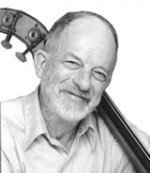Allegro
The Band Room
June '17
Volume 117, No. 6June, 2017

Bill Crow
www.BillCrowBass.com
The British tenor man and club owner Ronnie Scott once told about his attempt to teach himself to play the guitar. He would get home from his club at about 3 a.m. and would begin playing a little exercise over and over. One morning while he was playing, a mighty thumping began on the floor above. The guy upstairs couldn’t take it any more. Later Ronnie found a note that had been pushed through his letter box. It wondered how a man of Ronnie’s intelligence could make such a dreadful noise in the middle of the night. So Ronnie put a note through the neighbor’s door apologizing for the disturbance. He explained that Andrés Segovia was staying in his spare bedroom. The next morning brought a reply. The note said it was an honor and privilege to be awakened by Señor Segovia, and offered best wishes to the maestro.
![]() Bobby Van Deusen told this one on Facebook:
Bobby Van Deusen told this one on Facebook:
I was playing solo piano in a fine dining restaurant. There was a nice groove in the room. A patron came over and said, without salutation, “So, do you read music?” I said, “Sure, got something for me to read?” “No, we were just wondering.” After a few minutes of small talk, the guy asked, “Do you play any classical?” And he dropped three singles into my tip bowl. I had been practicing Chopin’s Fantasy Impromptu Opus 66 all that afternoon, so I tore into it full tilt. The guy said, “Whoa, whoa, whoa! I didn’t mean that classical!”
![]() Steve Johns sent me this one:
Steve Johns sent me this one:
Some time back in the middle 1970s the freelance musician community was abuzz with the news that the band on the Johnny Carson show would be temporarily augmented by two horn players, Brooks Tillotson and Earl Chapin. At that time, both musicians had grown full, rather scraggly beards.
Carson had just returned from a vacation. He introduced bandleader Doc Severinsen, and then said in a side comment, “I go away for one week, and you let two hermits into the band!”
Steve Johns also told me about a dilemma that occurred while he was associate tuba player with the Metropolitan Opera. One night as the musicians were getting ready for the performance, the principal tuba player told Steve that he had accidentally dropped his hairbrush into the bell of Steve’s tuba. They both tried to fish it out, but it had turned the corner of the tubing and was stuck, out of reach. Steve was unable to play that night, so he went home, where he put his tuba in the bathtub and filled it with water with a pressure hose. The hairbrush remained stuck in the tubing, and there was now about seventy-five pounds of water in the instrument. So Steve took the toilet plunger, cleaned it thoroughly, and used it to create a violent turbulence in the tuba, which eventually dislodged the hairbrush, and it floated to the top of the bell. Steve emptied the water from the tuba and dried it off, and says it was none the worse for wear.
![]() I got this note from my jazz pianist friend Hal Galper, who received this on his Facebook page from a friend: “I just tried to type Hal Galper’s name and my iPhone auto-corrected it to Glasper. Nothing against Robert, but that seems backward to me.”
I got this note from my jazz pianist friend Hal Galper, who received this on his Facebook page from a friend: “I just tried to type Hal Galper’s name and my iPhone auto-corrected it to Glasper. Nothing against Robert, but that seems backward to me.”
![]() Scott Robinson sent me this note:
Scott Robinson sent me this note:
Kathy Ridl is a fine violist/composer/arranger who also does excellent graphics work, and helps me with the CD covers for ScienSonic Laboratories. Last night she was making up a photo collage of musicians playing at the Lab, and I was bothered by the bright yellow foam ear plug that stuck out of Pat O’Leary’s ear. I’m very much in favor of using earplugs, and wear them all the time myself, but this bright yellow thing sticking out of his head among the mostly brown colors was very distracting. Kathy tried to Photoshop it out, but couldn’t get it to look natural. So I found another shot of Pat, without the earplug, and asked if she could just take that ear, or part of it, and drop it into the other shot. Kathy replied, “I’m charging you extra for cartilage!” (She made the switch, though, and it came out great!)
Scott also told me he recently went to City Hall to attend the Rally to Save the Arts, where funding for the NEA was a hot topic. He was reminded of a conversation about federal arts funding at his conservative Republican uncle’s house around the year 2000. The uncle was ranting about how the government shouldn’t be funding the arts, how they should do away with the NEA, the taxpayers can’t afford it, etc. Scott knew that the yearly cost per American for the entire budget of the NEA was roughly the cost of a postage stamp (33 cents at the time). He listened as long as he could stand it, and then stood up and fished a quarter and a dime out of his pocket. He handed them to his uncle and said, “Here, you can quit complaining. I’ve just paid your entire share of the NEA budget for the year!”
